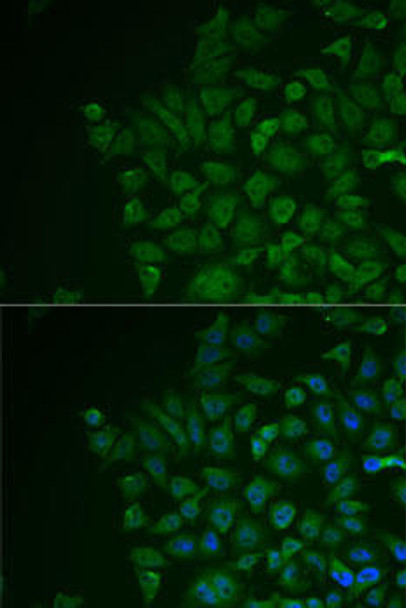Anti-LRAT Antibody (CAB13256)
- SKU:
- CAB13256
- Product Type:
- Antibody
- Reactivity:
- Human
- Mouse
- Rat
- Host Species:
- Rabbit
- Isotype:
- IgG
- Antibody Type:
- Polyclonal Antibody
- Research Area:
- Signal Transduction
Description
Anti-LRAT Antibody (CAB13256)
The LRAT Polyclonal Antibody (CAB13256) is a valuable tool for researchers studying lecithin retinol acyltransferase (LRAT), an enzyme involved in the metabolism of vitamin A. The antibody, generated in rabbits, exhibits high reactivity with human samples and is validated for use in Western blot applications. By binding specifically to the LRAT protein, this antibody enables precise detection and analysis in a variety of cell types, making it an essential component for investigations in the fields of biochemistry and nutrition.LRAT plays a crucial role in the conversion of retinol (vitamin A) into retinyl esters, which are necessary for normal vision and overall health.
Dysregulation of LRAT activity has been linked to various diseases, including eye disorders and metabolic conditions. This antibody provides researchers with the means to explore the functions of LRAT and its potential implications in human health and disease. By unraveling the mechanisms of LRAT, scientists can pave the way for novel therapeutic strategies aimed at targeting vitamin A metabolism pathways.
| Antibody Name: | Anti-LRAT Antibody |
| Antibody SKU: | CAB13256 |
| Antibody Size: | 20uL, 50uL, 100uL |
| Application: | WB IF |
| Reactivity: | Human, Mouse, Rat |
| Host Species: | Rabbit |
| Immunogen: | Recombinant fusion protein containing a sequence corresponding to amino acids 1-194 of human LRAT (NP_004735.2). |
| Application: | WB IF |
| Recommended Dilution: | WB 1:1000 - 1:2000 IF 1:50 - 1:200 |
| Reactivity: | Human, Mouse, Rat |
| Positive Samples: | Mouse lung, Rat small intestine |
| Immunogen: | Recombinant fusion protein containing a sequence corresponding to amino acids 1-194 of human LRAT (NP_004735.2). |
| Purification Method: | Affinity purification |
| Storage Buffer: | Store at -20'C. Avoid freeze / thaw cycles. Buffer: PBS with 0.02% sodium azide, 50% glycerol, pH7.3. |
| Isotype: | IgG |
| Sequence: | MKNP MLEV VSLL LEKL LLIS NFTL FSSG AAGE DKGR NSFY ETSS FHRG DVLE VPRT HLTH YGIY LGDN RVAH MMPD ILLA LTDD MGRT QKVV SNKR LILG VIVK VASI RVDT VEDF AYGA NILV NHLD ESLQ KKAL LNEE VARR AEKL LGFT PYSL LWNN CEHF VTYC RYGT PISP QSDK FCET VKII IRDQ RS |
| Gene ID: | 9227 |
| Uniprot: | O95237 |
| Cellular Location: | Cytoplasm, Endoplasmic reticulum membrane, Endosome, Rough endoplasmic reticulum, Single-pass membrane protein, multivesicular body, perinuclear region |
| Calculated MW: | 25kDa |
| Observed MW: | 26-55kDa |
| Synonyms: | LRAT, LCA14 |
| Background: | The protein encoded by this gene localizes to the endoplasmic reticulum, where it catalyzes the esterification of all-trans-retinol into all-trans-retinyl ester. This reaction is an important step in vitamin A metabolism in the visual system. Mutations in this gene have been associated with early-onset severe retinal dystrophy and Leber congenital amaurosis 14. Alternative splicing results in multiple transcript variants. |
| UniProt Protein Function: | LRAT: Transfers the acyl group from the sn-1 position of phosphatidylcholine to all-trans retinol, producing all-trans retinyl esters. Retinyl esters are storage forms of vitamin A. LRAT plays a critical role in vision. It provides the all-trans retinyl ester substrates for the isomerohydrolase which processes the esters into 11-cis-retinol in the retinal pigment epithelium; due to a membrane-associated alcohol dehydrogenase, 11 cis-retinol is oxidized and converted into 11-cis-retinaldehyde which is the chromophore for rhodopsin and the cone photopigments. Defects in LRAT are a cause of Leber congenital amaurosis type 14 (LCA14). It is a severe dystrophy of the retina, typically becoming evident in the first years of life. Visual function is usually poor and often accompanied by nystagmus, sluggish or near-absent pupillary responses, photophobia, high hyperopia and keratoconus. Belongs to the H-rev107 family. |
| UniProt Protein Details: | Protein type:EC 2.3.1.135; Transferase; Cofactor and Vitamin Metabolism - retinol; Membrane protein, integral Chromosomal Location of Human Ortholog: 4q32.1 Cellular Component: multivesicular body; endoplasmic reticulum membrane; rough endoplasmic reticulum; perinuclear region of cytoplasm; integral to membrane Molecular Function:retinoic acid binding; transferase activity, transferring acyl groups; retinol binding; phosphatidylcholine-retinol O-acyltransferase activity Biological Process: positive regulation of lipid transport; phototransduction, visible light; visual perception; retinol metabolic process; retinoic acid metabolic process; retinoid metabolic process; vitamin A metabolic process Disease: Leber Congenital Amaurosis 14; Retinitis Pigmentosa |
| NCBI Summary: | The protein encoded by this gene localizes to the endoplasmic reticulum, where it catalyzes the esterification of all-trans-retinol into all-trans-retinyl ester. This reaction is an important step in vitamin A metabolism in the visual system. Mutations in this gene have been associated with early-onset severe retinal dystrophy and Leber congenital amaurosis 14. Alternative splicing results in multiple transcript variants. [provided by RefSeq, Aug 2014] |
| UniProt Code: | O95237 |
| NCBI GenInfo Identifier: | 46576867 |
| NCBI Gene ID: | 9227 |
| NCBI Accession: | O95237.2 |
| UniProt Secondary Accession: | O95237,Q8N716, A8K983, |
| UniProt Related Accession: | O95237 |
| Molecular Weight: | 25,703 Da |
| NCBI Full Name: | Lecithin retinol acyltransferase |
| NCBI Synonym Full Names: | lecithin retinol acyltransferase (phosphatidylcholine--retinol O-acyltransferase) |
| NCBI Official Symbol: | LRAT |
| NCBI Official Synonym Symbols: | LCA14 |
| NCBI Protein Information: | lecithin retinol acyltransferase |
| UniProt Protein Name: | Lecithin retinol acyltransferase |
| UniProt Synonym Protein Names: | Phosphatidylcholine--retinol O-acyltransferase |
| Protein Family: | Lecithin retinol acyltransferase |
| UniProt Gene Name: | LRAT |
| UniProt Entry Name: | LRAT_HUMAN |













